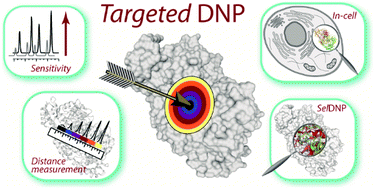Targeted DNP for biomolecular solid-state NMR
Abstract
High-field dynamic nuclear polarization is revolutionizing the scope of solid-state NMR with new applications in surface chemistry, materials science and structural biology. In this perspective article, we focus on a specific DNP approach, called targeted DNP, in which the paramagnets introduced to polarize are not uniformly distributed in the sample but site-specifically located on the biomolecular system. After reviewing the various targeting strategies reported to date, including a bio-orthogonal chemistry-based approach, we discuss the potential of targeted DNP to improve the overall NMR sensitivity while avoiding the use of glass-forming DNP matrix. This is especially relevant to the study of diluted biomolecular systems such as, for instance, membrane proteins within their lipidic environment. We also discuss routes towards extracting structural information from paramagnetic relaxation enhancement (PRE) induced by targeted DNP at cryogenic temperature, and the possibility to recover site-specific information in the vicinity of the paramagnetic moieties using high-resolution selective DNP spectra. Finally, we review the potential of targeted DNP for in-cell NMR studies and how it can be used to extract a given protein NMR signal from a complex cellular background.

- This article is part of the themed collection: Chemical Science Recent Perspective articles


 Please wait while we load your content...
Please wait while we load your content...